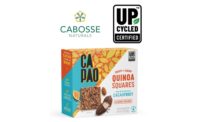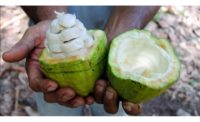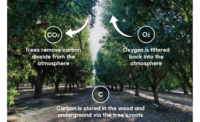As global Stop Food Waste Day (April 26) approaches and latest figures show that the average American family wastes nearly $2,000 worth of food a year, Cabosse Naturals is trying to help combat this global issue.
The U.S. is one of the top 10 chocolate-consuming countries in the world, with the average American consuming approximately 10 pounds of chocolate per year, per person.
However, many Americans don't realize that their favorite confectionery comes from the cacaofruit, 70% of which has been wasted once the beans are harvested: as much as 10 million tonnes a year.
Cabosse Naturals has started upcycling this largely undiscovered fruit, creating a range of 100% natural ingredients to be used in food manufacturing in the U.S. from its waste.
While there have been some innovative new products launched containing cacoafruit, Cabosse Naturals says there are several more in the pipeline, enabling Americans to taste cacaofruit for the first time. Candy Industry spoke to Sylvie Woltering-Valat, head of marketing, Cabosse Naturals, to get more information.
Liz Parker: Why did Cabosse Naturals start upcycling cacaofruit?
Sylvie Woltering-Valat: We've started to think about ways to upcycle the cacaofruit, because we realized there is much more to it than just its seeds. Take for example the pulp, it has its own delicious fruity taste that can apply to a wide range of applications. We realized that we were not using the fruit to its fullest potential.
Usually, the cacaofruit is harvested for its seeds to use in the manufacture of chocolate and cocoa products. However, the seeds represent only about 30% of the fruit, meaning that the rest—its pulp and peel—is generally discarded and simply goes to waste. While many Americans won’t be familiar with the cacaofruit, just like an apple or orange, it has its own uniquely fruity and delicious taste.
About 14 million tons of cacaofruit are harvested around the world annually, but up to 70% of the cacaofruit has been thrown away —that’s as much as 10 million tons a year.
We know that preventing food waste is the single greatest way of fighting climate change. In fact, if all harvested cacaofruit was used to its fullest, it would reduce the same amount of CO2 as planting 3.5 billion trees per year. That’s an area almost as vast as Texas and Kansas combined. Reason for us to start to lead the way.
LP: How did this create a range of 100% natural ingredients?
SWV: For years we’ve been working on creating a robust supply chain to harness the natural richness of this largely unused fruit. To preserve the fresh taste and nutrients of the fruit, we operate within a short window of four hours between the moment we open the fruit and upcycle the rest of the fruit into a range of 100% pure cacaofruit ingredients—juice, pulp, concentrate, and powder—which can be used in a number of ways in food and drink manufacture.
The cacaofruit pulp has a clean, fresh white color and a sweet scent of honey. With its pleasant zesty fruity flavor, it has a refreshing signature taste that brings natural sweetness and refreshing notes when used in drinks and snacks.
The juice has a zesty fruitiness, making it a refreshing fruit base for a large range of beverages, including functional beverages, ready to drink teas, coffees and even beers and kombuchas. It has a light yellow color with a fruity scent and naturally contains magnesium, potassium and antioxidants. It brings a deliciously exotic flavor to drinks.
Characterized by its golden brown color and a fruity honey scent, the concentrate is 100% pure and free from sweeteners, additives and preservatives. It adds an intense fruity sweetness and a signature flavor wherever used.
LP: What new products have recently been launched containing cacaofruit?
SWV: Some pioneering US brands have already seized the cacaofruit trend, including BevCacao who sells it at Walmart.
LP: Are there any new ones coming out soon, too?
SWV: There has been demand and interest in this new category and we predict more new and exciting products containing upcycled cacaofruit ingredients will come to the market in the next year.
LP: Why is 70% of the cacaofruit wasted once the beans are harvested?
SWV: For centuries the industry has focused on the seeds for the chocolate and cocoa production and overtime the association with the fruit has been lost. Processing the pulp and peel requires a different supply chain, where speed of processing is of essence to preserve the fresh aromas and nutrients of the fruit.
LP: Is there any way to use more of the cacaofruit—for example, in these new products?
SWV: Yes, absolutely. The sweet and fruity taste of the cacaofruit lends itself well to a range of snacks, confectionery and beverages, which we hope Americans will discover and enjoy, just like other countries are also beginning to do.
For example, in Belgium, craft beer Acan already contains upcycled cacaofruit ingredients, as do Kiukiu, a cocktail/mocktail drink and Altsternative, a non-alcoholic beer in Germany. Godiva Cafes in Japan offer a selection of cacaofruit sodas, and energy drink Kayu in the UK and Waitrose Wholefruit No. 1 chocolate, also in the UK. In Italy, Rogelfrut made a gelato of the cacaofruit too.








